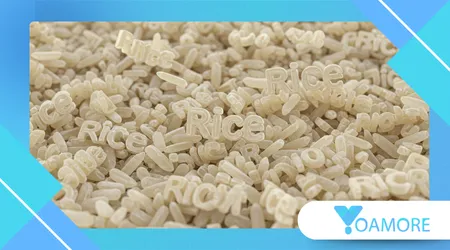Pourquoi certaines langues ont 15 mots différents pour « riz »

Vous êtes-vous déjà demandé pourquoi certaines langues ont autant de mots pour une seule chose, comme comment les langues ont 15 mots différents pour le riz?
Annonces
Cela semble excessif, mais cela révèle un lien fascinant entre la culture, l’environnement et la communication.
Cette plongée en profondeur explore comment une seule culture peut façonner un vocabulaire entier, reflétant son rôle central dans la vie quotidienne, l'histoire et l'identité.
Nous découvrirons les phénomènes linguistiques derrière cette complexité, examinerons comment différentes cultures classent et catégorisent le monde qui les entoure et apprécierons la richesse contenue dans nos mots.
L'importance culturelle du riz
Le riz est plus qu’un simple aliment ; c’est un pilier fondamental d’innombrables cultures à travers le monde.
Annonces
Son évolution, de simple céréale à culture de base, lui a conféré une importance sociale, économique et même spirituelle immense. Cette importance se reflète directement dans la façon dont on en parle.
Dans de nombreuses cultures asiatiques, le riz est indissociable de la vie quotidienne, du petit-déjeuner au dîner. Les différents états et formes du riz nécessitent un vocabulaire précis et riche.
Vous ne mangez pas seulement du « riz » ; vous mangez Gohan (riz cuit) au Japon ou nasi en Malaisie, chaque mot porte un contexte spécifique.
Les mots utilisés pour le riz racontent souvent une histoire sur sa préparation ou son utilité. Par exemple, certaines langues utilisent des mots pour désigner le riz cru, le riz cuit, le riz frit et même les restes.
Cette spécificité linguistique dénote une culture où chaque étape de la préparation des aliments est mise à l’honneur.
L'importance du riz s'étend aux coutumes sociales, comme les salutations et les rituels. Dans certaines sociétés, demander à quelqu'un si il a mangé du riz est une façon courante de s'enquérir de son bien-être.
Cela montre à quel point le grain est intégré dans le tissu même de l’interaction sociale.
Considérez le rôle du riz dans les grandes fêtes et les jours fériés. Les plats spéciaux nécessitent souvent des variétés de riz spécifiques, chacune portant un nom unique.
Ces noms ne sont pas de simples étiquettes ; ils font partie d’un patrimoine culturel commun transmis de génération en génération.
Le lien profond avec le riz témoigne de son rôle de source de subsistance et de symbole de prospérité.
Il n’est donc pas surprenant que les langues ont 15 mots différents pour le riz, voire plus, pour en saisir toutes les nuances.
+ Les gauchos argentins et le code d'honneur rural
Une question de survie et d'économie
L'abondance de mots pour désigner le riz n'est pas un hasard ; c'est une question de praticité et de survie. Pour les communautés qui dépendent du riz comme principale source de nourriture et moteur économique, il est essentiel de distinguer les différents types de riz.
Les agriculteurs doivent discuter avec précision des différentes variétés de riz. Ils doivent distinguer le riz à grains longs, le riz à grains courts et le riz gluant, car chacun a des exigences de culture différentes.
La capacité à articuler ces distinctions est essentielle à la réussite agricole.
De même, les commerçants et les négociants ont besoin d’un lexique précis pour mener leurs affaires.
Le terme « riz brisé » peut désigner un produit de qualité inférieure, tandis que le terme « riz nouveau » désigne un lot fraîchement récolté et de qualité supérieure. Ces termes influencent directement le commerce et la valeur.
L'économie de régions entières peut dépendre de la production rizicole. La langue évolue pour accompagner cette réalité économique, créant un vocabulaire détaillé et spécifique.
Ce phénomène est un parfait exemple de langue s’adaptant aux besoins de ses locuteurs.
Considérez-le comme un vocabulaire technique spécialisé pour la vie quotidienne. Tout comme un mécanicien possède de nombreux mots pour désigner les différentes pièces d'un moteur, un agriculteur issu d'une culture rizicole possède un vocabulaire riche pour ses cultures.
Ce niveau de détail est également présent dans d'autres domaines, comme la multitude de mots utilisés par les Inuits pour désigner la neige. C'est un exemple classique de l'hypothèse Sapir-Whorf, selon laquelle le langage façonne la perception et la pensée.
+ La langue sans verbes : bienvenue en indonésien Riau
L'analogie d'un peintre et de ses couleurs

Imaginez un peintre professionnel. Il n'utilise pas seulement de la peinture « bleue ». Il utilise des couleurs outremer, cobalt, céruléen et bleu sarcelle, chacune avec une teinte, une texture et un effet différents.
Un peintre a besoin de ce vocabulaire étendu pour créer un chef-d’œuvre.
De même, une culture profondément liée au riz nécessite un vocabulaire riche pour le décrire. On ne se contente pas de voir un seul type de riz ; on en perçoit les différentes textures, formes et utilisations.
Cette précision leur permet de communiquer des intentions culinaires précises.
Un chef au Vietnam, par exemple, pourrait avoir besoin de spécifier le type exact de riz gluant pour un dessert comme ché, car le remplacer gâcherait le plat.
La langue leur donne les outils pour être précis et réussir.
Cette précision linguistique met en évidence la valeur et l’importance accordées à un élément spécifique au sein d’une culture.
Plus un objet est important, plus la langue est susceptible de disposer d’un vocabulaire nuancé et détaillé pour le décrire.
C'est une magnifique illustration de l'imbrication entre l'ingéniosité humaine et la nécessité environnementale. Le vocabulaire devient un outil de survie, de créativité et d'expression.
+ Cas curieux de réduplication dans le langage courant
L'évolution linguistique
Les langues ne sont pas statiques ; elles évoluent pour refléter le monde de leurs locuteurs. Le mot « riz » en est un parfait exemple.
À mesure que de nouvelles variétés étaient cultivées et que de nouveaux plats étaient créés, de nouveaux mots étaient nécessaires pour les décrire.
Considérez l'évolution d'un seul terme. Un mot désignant « riz non cuit » pourrait éventuellement donner naissance à de nouveaux mots pour « paddy », « riz décortiqué » et « riz blanchi ». Il s'agit d'un processus naturel de ramification et de spécialisation linguistiques.
La multitude de mots désignant le riz témoigne de milliers d'années d'interaction humaine avec cette culture. Elle reflète une histoire d'agriculture, de commerce et d'innovation culinaire.
Les langues ont 15 mots différents pour le riz parce que les cultures ont passé des siècles à perfectionner sa culture et sa préparation.
Il ne s’agit pas d’un choix arbitraire, mais d’une conséquence directe du développement historique et culturel.
Selon une étude publiée dans la revue Science en 2021, la domestication du riz a eu un impact profond et mesurable sur le développement linguistique de nombreuses cultures à travers l’Asie.
Les chercheurs ont constaté que le vocabulaire lié au riz s’est considérablement développé parallèlement aux progrès agricoles, démontrant une corrélation directe entre les pratiques culturelles et la complexité linguistique.
L’étude, intitulée « La coévolution de la riziculture et de la langue en Asie », établit un lien clair entre l’activité humaine et les mots que nous utilisons.
Exemples de diversité linguistique
Pour bien saisir ce concept, il est utile de se pencher sur des exemples concrets. Examinons quelques langues qui présentent cette richesse linguistique.
En coréen, par exemple, il existe différents mots pour désigner le riz en fonction de son état. Ssal (쌀) est du riz non cuit, tandis que bap (밥) est du riz cuit.
Cette simple distinction est fondamentale dans la conversation quotidienne et montre à quel point le riz fait partie intégrante de la langue.
Un autre exemple se trouve dans la langue khmère du Cambodge. Angkar signifie riz non cuit, baie c'est du riz cuit, et srâe fait référence à une rizière.
La langue distingue non seulement le grain lui-même mais aussi son origine, soulignant son importance dans l’agriculture.
Ces exemples ne sont pas isolés ; on les retrouve dans d'innombrables langues d'Asie et d'ailleurs. La terminologie précise du riz est une caractéristique universelle des cultures où le riz est un élément essentiel de la vie.
| Langue | Mot pour riz non cuit | Mot pour riz cuit | Mot pour rizière |
| coréen | Ssal (쌀) | Bap (밥) | N / A (논) |
| Khmer | Angkar (អង្ករ) | Baie (បាយ) | Srâe (ស្រែ) |
| vietnamien | Gao | Cơm | Ruộng lúa |
| thaïlandais | Khao San (ข้าวสาร) | Khao (ข้าว) | Thung na (ทุ่งนา) |
| japonais | Kome (米) | Gohan (ご飯) | Ta (田) |
Ce tableau montre comment différentes langues classent le riz. Chaque colonne représente un concept distinct, et chaque mot révèle le lien culturel spécifique avec le riz, du grain cru au plat cuisiné, en passant par la terre où il pousse.
Le pouvoir du langage et des relations humaines
Le fait incroyable que les langues ont 15 mots différents pour le riz Ce n'est pas une mince affaire. C'est une fenêtre ouverte sur l'expérience humaine.
Cela nous montre à quel point nous sommes profondément connectés à notre environnement et comment nous utilisons le langage pour donner un sens au monde.
Cette richesse de vocabulaire nous aide à apprécier la complexité des autres cultures. Elle nous encourage à aller au-delà des simples traductions et à approfondir notre compréhension. Elle nous rappelle que les mots sont porteurs d'histoire, de valeurs et de traditions.
La prochaine fois que vous entendrez un nouveau mot pour un objet familier, prenez un moment pour réfléchir à son contexte culturel. Vous pourriez bien découvrir une histoire fascinante cachée dans un seul mot.
Pour approfondir la relation complexe entre la langue et la culture, vous pouvez explorer des ressources telles que Ethnologue base de données qui documente des milliers de langues dans le monde entier.
En fin de compte, ce phénomène linguistique constitue un puissant témoignage de la diversité de l’expérience humaine et de la créativité infinie du langage.
Cela nous rappelle que la langue n’est pas seulement un outil de communication, mais une partie vivante et respirante de notre patrimoine culturel.
Pour en savoir plus sur ce sujet, consultez cet article intéressant de Radio Nationale Publique sur la façon dont la nourriture façonne le langage.
Conclusion
L'idée que les langues ont 15 mots différents pour le riz est un bel exemple de la façon dont la culture, l’environnement et la nécessité façonnent notre vocabulaire.
C’est un témoignage de l’importance de cette céréale dans la vie de milliards de personnes et du rôle puissant qu’elle joue dans leur histoire, leur économie et leur identité.
Ce n'est pas une coïncidence, mais une profonde réflexion sur l'adaptation humaine. Cela montre comment nos mots évoluent pour répondre à nos besoins, offrant un moyen plus riche et plus précis d'exprimer le monde qui nous entoure.
FAQ : questions que vous pourriez avoir
Pourquoi toutes les langues n’ont-elles pas autant de mots pour le riz ?
Le nombre de mots pour un objet dépend de son importance au sein d'une culture. Dans les cultures où le riz n'est pas une source alimentaire principale, un seul mot suffit souvent, car il n'y a pas de nécessité pratique ou culturelle de termes plus spécifiques.
Ce phénomène s’applique-t-il à d’autres aliments ?
Absolument. On observe des tendances similaires avec d'autres aliments de base, comme les pommes de terre dans les régions andines d'Amérique du Sud ou le pain dans de nombreuses cultures européennes. Plus un aliment est intégré à une culture, plus son vocabulaire tend à être riche.
Est-ce vraiment 15 mots, ou est-ce une figure de style ?
Le nombre « 15 » est souvent utilisé comme figure de style pour indiquer un grand nombre. Si certaines langues en comptent davantage, d'autres moins, l'important est qu'elles possèdent un vocabulaire étendu pour le riz. Le nombre exact varie selon la langue et le dialecte.
